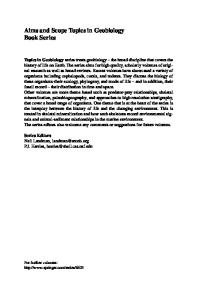On the Origin of Stiffening in Biopolymers
- PDF / 501,412 Bytes
- 7 Pages / 595 x 842 pts (A4) Page_size
- 86 Downloads / 324 Views
L3.1.1/BB3.1.1
On the Origin of Stiffening in Biopolymers Erik Van der Giessen, Teun Koeman, Teun van Dillen and Patrick Onck Materials Science Center, University of Groningen, Nijenborgh 4, 9747 AG Groningen, The Netherlands ABSTRACT Strain stiffening of protein networks is explored by means of a finite strain analysis of a twodimensional network model of cross-linked semiflexible filaments. The results show that stiffening is caused by non-affine network rearrangements that govern a transition from a bending dominated response at small strains to a stretching dominated response at large strains. Thermally-induced filament undulations only have a minor effect; they merely postpone the transition. INTRODUCTION There is a deep interest in the mechanical response of biological tissues and gels in view of the importance for biological functions such as cell motility and mechanotransduction. Many network-like biological tissues respond to deformation by exhibiting an increasing stiffness, i.e. ratio between change of stress and change of strain. This has been demonstrated by micropipette and microtwisting experiments [1] on individual cells and through rheological experiments on in-vitro gels of cytoskeletal filaments (actin, vimentin, keratin [2–4] and neuronal intermediate filaments [5]), as well as on fibrin [6, 7]. These biological gels fall within the class of semiflexible polymers, which has also attracted much theoretical attention in the last decade [8–12]. However, these theoretical studies have primarily focused on the small-strain regime, tractable for analytical treatment. In a simple conceptual view, a biopolymer network is an interlinked structure of filaments. Thus, stiffening can result from stiffening of the polymeric filaments between cross-links, from alterations in the network structure, or both. The current paradigm is that stiffening is primarily due to the stiffening of the filaments themselves. This idea has been worked out in detail very recently by Storm et al. [5] by adopting the worm-like chain model for actin filaments in combination with the assumption that the network deforms in an affine manner, i.e., each filament is assumed to follow the overall deformation. The worm-like chain model is a well-documented description for the stretching of semiflexible polymers, where the longitudinal stiffness of undulated filaments is attributed primarily to bending; the axial stiffness of the polymeric chain itself is much higher [8]. As the filament is stretched (at constant temperature), the amplitude of the transverse thermal undulations reduces and, as a consequence, the stiffness increases. In the limit that the filament is pulled straight, all subsequent axial deformation would have to originate from axial straining of the chain, but at an enormous energy cost. Given this description of individual filaments, Storm et al. [5] proceed by considering a network consisting of infinitely many filaments. Initially the filaments are randomly orientated, and as the sample is deformed the network is assum
Data Loading...











